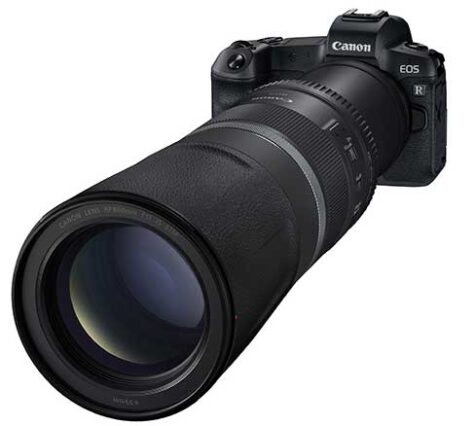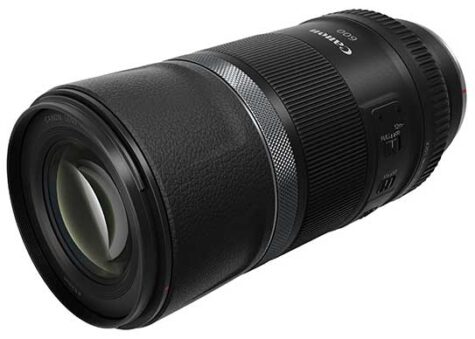CANON RF 600mm and 800mm f/11 IS STM: Two revolutionary lenses that are fun to use bring hand-held super-tele shooting to everyday photographers. Though not without their own challenges out in the field, the combination of weight, price and built-in stabilisation make Canon’s RF 600mm f/11 IS STM and RF 800mm f/11 IS STM as exciting as the company’s new R5 and R6 cameras.
RRP: 600mm – around $1400 (US$699); 800mm around $1800 (US$899)

Designed for Canon’s full frame mirrorless cameras, the RF 600mm f/11 IS STM and RF 800mm f/11 IS STM can be classed as the most innovative imaging products to be released during 2020. Before these lenses were released, super-telephoto lenses were universally large, heavy and very expensive, putting them beyond the reach of most photographers. These two lenses change that paradigm since they are a fraction of the weight and price of their EF lens equivalents.
By comparison, the RF 600mm f/11 IS STM weighs 930 grams, compared with 3.05 kg for the EF 600mm f/4L IS III USM lens, while the RF 800mm f/11 IS STM weighs 1.26 kg, compared with 4.5 kg for the EF 800mm f/5.6LIS USM lens. Cost-wise the difference is even more dramatic, with the RF 600mm f/11 IS STM selling for between $1250 and $1350, while the RF 800mm f/11 IS STM is under AU$2000. In contrast, Canon’s EF 600mm f/4L IS III USM lens and EF 800mm f/5.6LIS USM lenses are priced at around $18,000!
Designed for cameras with the RF Mount, the new f/11 lenses come with built-in optical Image Stabiliser technology and both support Dual Pixel CMOS AF when paired with a Canon EOS R System mirrorless camera. Both lenses have been developed to be used hand-held thanks to the use of Diffractive Optics, combined with a fixed f/11 aperture. A retractable barrel structure makes them easy to transport and store. Stepping motor (STM) focus adjustment means that autofocusing can be extremely quiet and very smooth while the Lens Control Ring on both models provides enthusiasts with direct and speedy adjustment for settings such as shutter speeds, exposure compensation or ISO sensitivity.
The RF 600mm f/11 IS STM will focus to within 4.5 metres of subjects, while the minimum focus of the RF 800mm f/11 IS STM is six metres. Both lenses claim four stops of built-in shake correction. The RF 600mm accepts 82mm filters, while the RF 800mm lens has a 95 mm diameter filter thread. Neither lens comes with a lens hood but the 600mm lens accepts the ET-88B and the 800mm lens the ET-101, providing re-sellers with bundling opportunities.
Purchasing Points:

1. The retracting design that helps to make these lenses compact will need to be explained to potential buyers. The lens is unlocked by turning the lock ring to the left, pushing the barrel forwards and then turning the lock ring back to the right to hold the barrel in place. Pictures can’t be taken until it is in position.
2. Both lenses take advantage of the Dual Pixel CMOS AF II autofocusing systems in Canon’s EOS-R series cameras. Focusing is internal and driven by a stepping motor, which is fast, quiet and precise, making these lenses suitable for shooting video.
3. Both lenses provide useful working distances for shooting close-ups of wildlife and sports, especially when the photographer is unable to get close to the action. This makes them ideal for birders as well as for shooting water sports and animals in zoos and wildlife sanctuaries.
4. Built-in stabilisation in both lenses provides up to four stops of shake correction and works with both auto and manual focusing. This factor makes both lenses ideal for hand-held shooting and highly attractive to photographers who enjoy taking pictures at air shows. Shutter speeds as slow as 1/100 second are possible with good shooting technique.
5. Both lenses have standard tripod fittings on the base of the outer barrel. Because they are so light, a tripod collar is not required.
6. Bokeh is surprisingly smooth for f/11 lenses, particularly when backgrounds are evenly-lit. (Note: bright background highlights can often be outlined.)
7. Neither lens is weather-resistant, although the two optional teleconverters are. Protective cases should be offered to customers who plan to use these lenses in changing weather conditions.
8. Perspective compression is a key feature of both lenses, which produce a much flatter perspective than a standard telephoto lens. This feature should be taken into account when the lenses are used for portraiture (human or animal).
9. Because aperture adjustments are not supported, users of these lenses will be required to shoot with the P, Tv or M modes. The auto ISO range will need to be restricted to keep relatively low noise levels wherever possible.
10. Both lenses can be used with Canon’s RF Extender 1.4x and RF Extender 2x teleconverters, which reduce the effective apertures to f/16 and f/22, respectively.
Distributor: Canon Australia; 1800 021 167; www.canon.com.au.





Be First to Comment